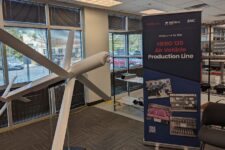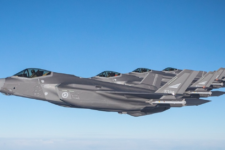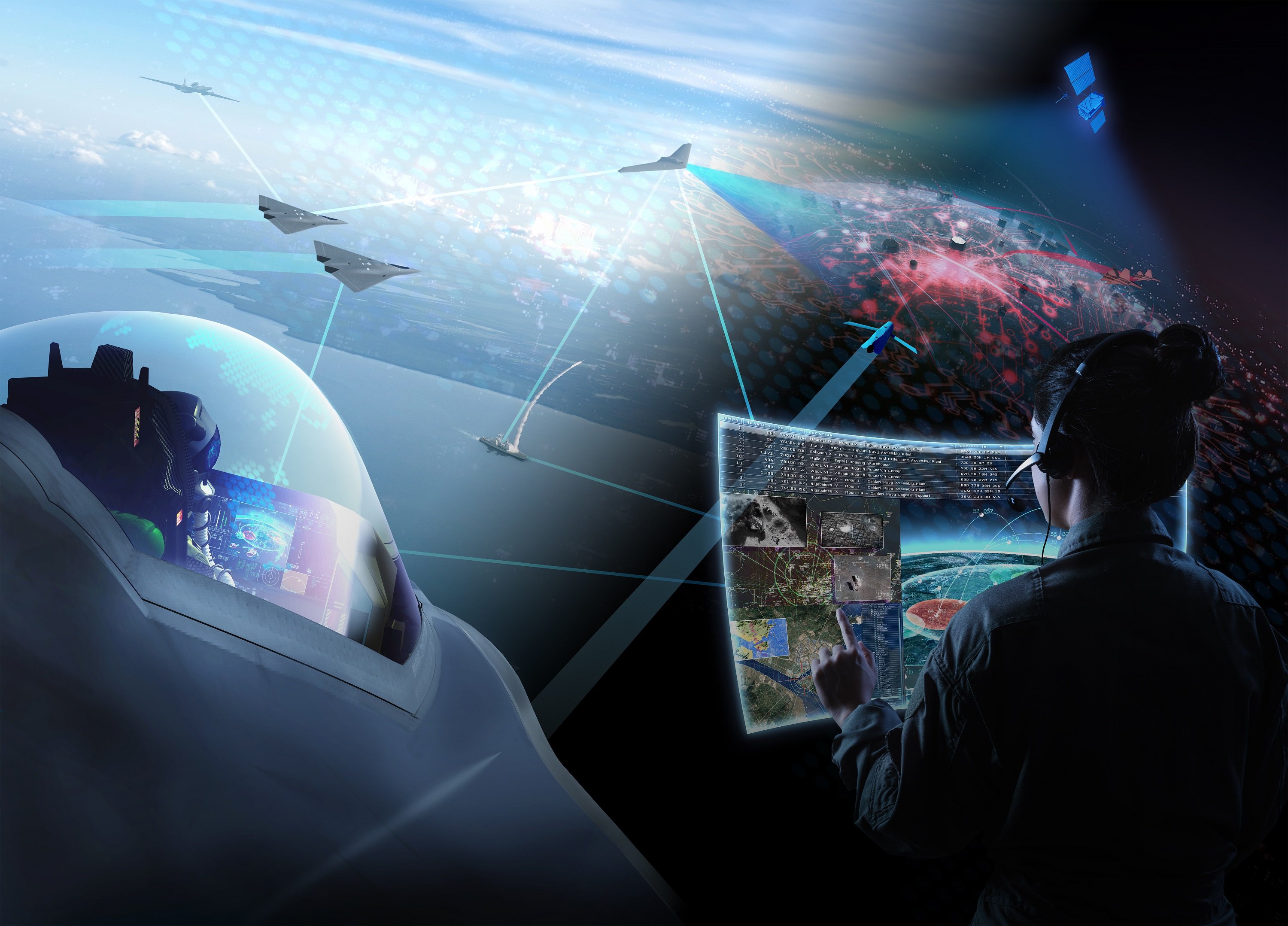In this Q&A with Stephanie C. Hill, Lockheed Martin’s executive vice president for Rotary and Mission Systems, we discuss how AI/ML, open systems, and edge computing enable JADO.
Breaking Defense: How can the aerospace and defense industry help solve the services’ Joint All-Domain Operations (JADO) and joint command and control challenges?
Hill: Gen. John Murray, commanding general for Army Futures Command recently said, “Start with a problem, don’t start with a solution and allow people to be innovative.” I agree wholeheartedly and know our industry can help the military services advance JADO in several ways. First, we are always listening to our customers and need to stay completely in sync so we understand those challenges. Then, through experimentation we can find new, better ways to solve those challenges together without having to go through a lengthy acquisition process.
For instance, we’re working with each of the services to accelerate integration between ISR, command and control, and fire control systems. The key is using artificial intelligence and machine learning in an open, standards-driven environment for cross-service integrated air and missile defense. This includes developing machine-to-machine interfaces to connect the Army and Navy in a long-range precision fires mission, which we’re demonstrating at this year’s Northern Edge exercise. Whereas larger programs tend to have months, if not years, of schedule to certify, install and test capability in operational environments, exercises such as this challenge the service and industry teams to install and test systems in days – sometimes hours.
We also recognize that the AI technology space is rapidly evolving with the commercial world leading the way. That’s why our LM Ventures team, our venture capital arm, has been working to source innovative technologies coming from the startup world. To date, about 40% of their investment dollars have gone to pursuing software for explainable AI, advanced sensor tech for data generation as well as high performance computing for edge processing.
Breaking Defense: What JADO-enabling capabilities are an immediate need and how soon could those become available?

Stephanie C. Hill, Executive Vice President of Rotary and Mission Systems (RMS) for Lockheed Martin Corporation.
Hill: Our defense customers such as Army Chief of Staff Gen. James McConville talk about the need for a joint all-domain solution that ties together sensors and shooters to enable decision dominance and overmatch. This essentially means you can make good decisions faster than your opponent.
To help our armed forces navigate complex, highly-contested battlefields, we’re bringing them greater connectivity using 5G.MIL™, AI, and machine learning. We’re also developing technologies with higher throughput and the ultra-low latency needed for edge devices, like survivable, autonomous vehicles, so they can operate in the joint battlespace while fully harnessing the power of artificial intelligence. Many of these capabilities are available and in use today.
For example, the Missile Defense Agency’s Command, Control, Battle Management and Communications (C2BMC) program is currently integrating C2 elements for the U.S. missile defense system and operates across every battlespace domain. Since 2004, our team has been evolving C2BMC so the Missile Defense System can connect to U.S. armed forces at 33 locations worldwide, including U.S. Strategic, Northern, European, Pacific, and Central Commands. And we continue to improve the program’s decision making by demonstrating AI/ML in areas such as hypersonic path prediction and battle management aids.
The services must also have the ability to make fast upgrades to platforms without worrying about vendor lock, which is why we’re continuing to advance and demonstrate those capabilities through solutions that leverage open architectures like Open Mission Systems standards. Furthermore, we’re advancing Multi-Level Security on various airborne platforms and ground stations to enable secure data transfer.
Another exciting area of development for JADO is the work going on around space-based connectivity. Lockheed Martin is currently building 10 satellites for the Space Development Agency Transport Layer, which will introduce Link-16 from space – further connecting nodes like F-16 fighters, THAAD, PAC-3 missiles, and Aegis within our Integrated Air-and-Missile Defense system. This beyond-line-of-site tracking, targeting and communications will dramatically extend U.S. warfighting options and allow additional coalition and allied partners to eventually bring their capabilities into the network. That kind of true interoperability is what JADO is all about.
Breaking Defense: How can industry partner with the services to accelerate the fielding of JADO capabilities?
Hill: Industry can support the services in three ways – by producing new capability through modifications to existing products; by creating new technology that outpaces the threat; and by proving these capabilities through experiments with leave-behind capabilities for the warfighter.
In the area of producing new capability, the services are adopting more of a “fail-fast” mentality and that requires industry investment, experimentation, and demonstrations in efforts like the Air Force’s Advanced Battle Management System and the Army’s Project Convergence. In support of both of those efforts, we recently provided real-time 5th-generation data to operators on the ground by linking a U-2, five F-35s, and an F-22 through “Project Hydra.”
For the Navy’s recently announced Project Overmatch, we have proposed multiple capabilities, including better multi-domain threat identification and targeting, unmanned carrier aviation mission control, and delivery of 5th-generation data from air and space to maritime assets. Going forward, these will introduce greater mission flexibility across all domains and provide an enhanced total operational picture for the joint warfighter.
Regarding new technology, one of the modernization tools that will support the Army’s transformation to a multi-domain operational force is Future Vertical Lift, which includes the Future Attack Reconnaissance Aircraft (FARA) and Future Long-Range Assault Aircraft (FLRAA) programs. We designed both our FARA solution, RAIDER X®, and FLRAA solution, DEFIANT X™, to support JADO in the Indo-Pacific theater. These agile, highly maneuverable aircraft offer high-speed, agile, low-level flight capabilities, which we demonstrated at Redstone Arsenal in Huntsville, AL, last month. They will bring the transformational strategic and operational reach the warfighter requires in 2030 and beyond.
On learning through experimentation, for the past three years we’ve been working with INDOPACOM and EUCOM. Using a crawl, walk, run approach through joint exercises such as Valiant Shield, we’re advancing solutions to help achieve one of their main goals – delivering synchronized lethal and non-lethal effects from “near-and-far, every axis, and every domain.” Together, we are building a distributed network of the virtualized Aegis weapon system C2 nodes to assist the warfighter in coordinating digital force orders. We’re leveraging existing Aegis Common Source Library software architecture to connect platforms and enable cross-domain kill webs – making in-stride software fixes via DevSecOps.
We are also leveraging the Common Mission Control Center developed in partnership with the Rapid Capabilities Office. In addition to the learning that takes place after experimentation, another benefit is that we can provide the warfighter with leave-behind capabilities.
Breaking Defense: How is Lockheed Martin advancing JADO capabilities through artificial intelligence and machine learning?
Hill: These are two critical JADO enablers and we’re applying them to help the services maximize safety, performance, and situational awareness across land, sea, air, space, cyber and the electromagnetic spectrum.
Our major platforms and programs – both current and future – are the logical landing spots for AI, which is why we are early adopters and have been working to gain our customers’ trust in those systems through demonstrations and capability insertion on current programs. We are tying current core programs to future franchise opportunities by focusing on four key AI areas that include: battle management command and control for cognitive battle management; ISR for decision-making; AI supporting autonomous mission systems; and training and sustainment for real-time mission integration across platforms and predictive health and maintenance.
For example, we’re delivering predictive maintenance algorithms for more than 130 systems and complementary machine-learning algorithms to significantly improve flight line diagnostics for the C-130. We have approximately 100 algorithms in development for critical F-35 flight/mission systems, as well as structural and propulsion components. And we are applying predictive maintenance to new military aircraft such as the Future Vertical Lift program to create a paradigm shift for global readiness. For the Navy, we’re using multiple AI-enabled tools to predict potential system or part failures for their critical assets.
In the area of C2, our DIAMONDShield system uses AI algorithms to automate the mission planning process – generating Air Tasking Orders in hours rather than days.
For ISR, we are training AI/ML applications to assist operators and decision makers in intelligent preparation of the battlefield. We can alert the operator to changes and predict future events. Our “Global Automated Target Recognition” processes large data sets finding targets in seconds, which historically would take analysts a day or more. With these AI-assisted applications, decision makers can close the kill web faster thanks to sensors deployed on tactical satellites, UAVs and other platforms from multiple domains.
For any system, we understand that trust is paramount as decision-making starts moving away from human operators in the loop towards human operators on the loop.
Breaking Defense: How should the government involve industry to showcase emerging JADO technologies and capabilities while validating concepts and informing potential solutions?
Hill: Industry’s willingness to invest, assume risks and innovate is directly reflective of our military customers’ willingness to collaborate on concepts of operation, conduct operational analysis and experiment with us.
The government should continue conducting industry engagements to inform us about current challenges and future concepts where they need solutions. And industry must be ready to act.
We’ve been doing this with various emerging technologies and today we’re seeing the results. Our land-based hypersonics, for example, are holding at-risk threats at ranges that were inconceivable even two years ago. This year, we’re also continuing to demonstrate our open standards-based Multi-Function Electronic Warfare-Air Large (MFEW-AL) solution, the longest-range Army sensor and effector, at various exercises. And our recent efforts with INDOPACOM and across all the services on joint exercises like Valiant Shield and Northern Edge are a testament to our commitment and partnership.






















